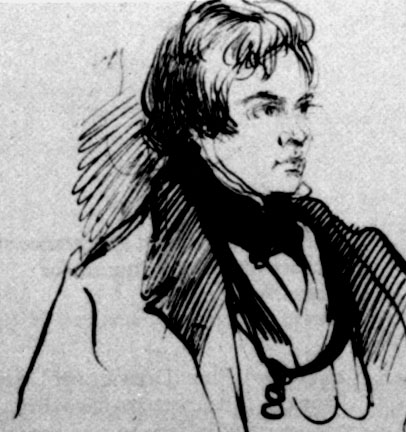
 John Forster (1812-1876) edited the
Foreign Quarterly Review , the Daily News, and The Examiner (1847-56). He
produced an admirable series of essays dealing with the
seventeenth-century Puritan Commonwealth: Lives
of the Statesmen of the Commonwealth (1836-9),
Arrest of Five Members (1860), Debates
on the Grand Remonstrance (1860), and Sir
John Eliot, A Biography (1864). He is best
remembered, however, as the author of the first
biography of Charles Dickens (3 vols., Chapman and
Hall, 1871-4), Landor (1868), and the first
volume of The Life of Swift (1875). p.
531 (Cambridge Biographical Dictionary,
p.531.
John Forster (1812-1876) edited the
Foreign Quarterly Review , the Daily News, and The Examiner (1847-56). He
produced an admirable series of essays dealing with the
seventeenth-century Puritan Commonwealth: Lives
of the Statesmen of the Commonwealth (1836-9),
Arrest of Five Members (1860), Debates
on the Grand Remonstrance (1860), and Sir
John Eliot, A Biography (1864). He is best
remembered, however, as the author of the first
biography of Charles Dickens (3 vols., Chapman and
Hall, 1871-4), Landor (1868), and the first
volume of The Life of Swift (1875). p.
531 (Cambridge Biographical Dictionary,
p.531.
Born the same year as Charles Dickens, but far to the north of England, at Newcastle-on-Tyne, John Forster was born the son of a local butcher, but rose to prominence in London literary circles in the 1830s. After attending Newcastle Grammar School, in 1828 Forster travelled south, to London with the intention of becoming a lawyer; however, after attending University College and the Inner Temple, in 1832 he elected to become a journalist instead. Forster quickly made a name for himself in literary circles as a critic of drama and literature. Within a few years, his friends included Romantic essayists Charles Lamb (1775-1834) and Leigh Hunt (1784-1859); the great actor-manager of Drury Lane, William MacReady (1793-1873); the artist and illustrator Daniel Maclise (1806?-1870); the novelist and statesman Sir Edward G. D. Bulwer-Lytton; the eminent historian of the French Revolution, Thomas Carlyle (1795-1881), and the poets Walter Savage Landor (1775-1864) and Robert Browning (1812-1889), and the Victorian poet-laureate, Alfred, Lord Tennyon (1809-1892). Forster's
friendships survived his notorious abruptness of manner and intolerance of contradiction (summed up by the cabman's description of him as ['the harbitrary cove') characteristics which CD [Charles Dickens] transformed to Podsnap in Our Mutual Friend . [Bentley et al., 95]
Leaving the Inner Temple, Forster joined the staff of The Examiner , to which he contributed favourable reviews of Dickens's earliest stories, collected in 1836-7 as Sketches by Boz . Forster first met Dickens on Christmas Day, 1836, through a mutual acquaintance, the novelist William Harrison Ainsworth (1805-82). Already, Forster's Lives of the Statesmen of the Commonwealth had begun publication at this time in Lardner's Cabinet Cyclopaedia. The frequent correspondence between the contemporaries eventually led to the travelogue American Notes for General Circulation (2 vols., Chapman and Hall, 1842), which is based on the letters which the novelist wrote to Forster during his first American reading tour (22 January-7June, 1842), an experience which contributed significantly to Dickens's Martin Chuzzlewit (1843). Over the late 1830s the two young men were so intimately connected in publishing matters that, as Robert L. Patten has noted, Forster became Dickens's "unofficial literary agent from the days of Pickwick onward."
From no. 15 of The Pickwick Papers onwards, Forster saw all proofs of Dickens' writing, and for later novels was consulted by the novelist during planning, writing, and revision; on occasions when Dickens was absent from London, he usually deputed decisions about proof corrections to Forster. The connection between them was so great that Dickens entrusted Forster alone with the secret childhood trauma which lay behind so many of his works, the blacking factory episode; during the composition of David Copperfield, Dickens confided this secret when he committed to Forster's care the autobiographical fragment that he had utilized in writing the novel. Briefly Forster succeeded Dickens as editor at the Daily News in 1846, and subsequently became part-proprietor of Household Words (1850). Forster's rooms at 58 Lincoln's Fields, his home from 1834 until his marriage in 1856, are said to be the basis for the residence of the lawyer Tulkinghorn in Bleak House. Owing to his jealousy of Dickens's younger friends, such as Wilkie Collins, in his biography Forster tends to downplay the role of that writer in Dickens's later years. Forster advised Dickens legally when the novelist separated from his wife in the 1850s, and was one of the executors of Dickens's will.
References
Bentley, Nicholas; Slater, Michael; and Burgis, Nina. The Dickens Index . Oxford: UP, 1990. Pp. 95-96.
Cambridge Biographical Dictionary ed. Magnus Magnusson. Cambridge: UP, 1990.
Page, Norman. A Dickens Companion . New York: Schocken Books, 1984. Pp. 32-33.
Last modified 31 July 2004